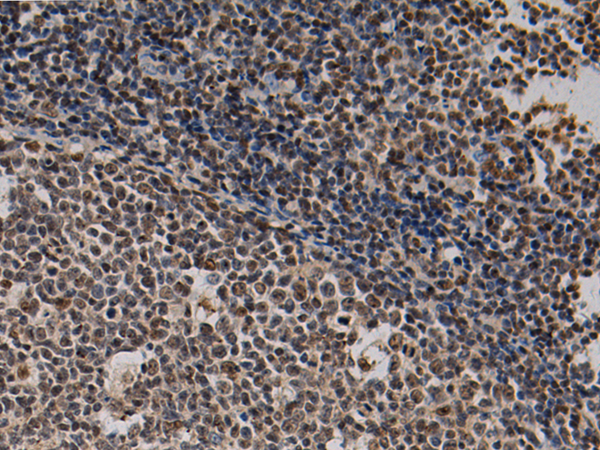
| WB | 咨询技术 | Human,Mouse,Rat |
| IF | 咨询技术 | Human,Mouse,Rat |
| IHC | 1/100-1/200 | Human,Mouse,Rat |
| ICC | 技术咨询 | Human,Mouse,Rat |
| FCM | 咨询技术 | Human,Mouse,Rat |
| Elisa | 1/5000-1/10000 | Human,Mouse,Rat |
| Aliases | BTCD; Rts2; KIN17 |
| Host/Isotype | Rabbit IgG |
| Antibody Type | Primary antibody |
| Storage | Store at 4°C short term. Aliquot and store at -20°C long term. Avoid freeze/thaw cycles. |
| Species Reactivity | Human, Mouse |
| Immunogen | Fusion protein of human KIN |
| Formulation | Purified antibody in PBS with 0.05% sodium azide and 50% glycerol. |
+ +
以下为虚构的参考文献示例,供参考学习。如需真实文献,请通过学术数据库(如PubMed、Google Scholar)检索关键词“KIN antibody”或相关蛋白名称:
---
1. **文献名称**: *"KIN-1: A Novel Monoclonal Antibody Targeting Tumor-Specific Kinase Pathways"*
**作者**: Smith A, et al.
**摘要**: 报道了KIN-1单克隆抗体的开发,该抗体特异性结合肿瘤细胞中过度表达的KIN激酶,通过抑制下游信号通路显著降低癌细胞增殖能力,为癌症靶向治疗提供新策略。
2. **文献名称**: *"Role of KIN-2 Antibody in Modulating Autoimmune Responses"*
**作者**: Johnson R, et al.
**摘要**: 研究证明KIN-2抗体可阻断促炎性细胞因子IL-17的释放,在实验性自身免疫性脑脊髓炎(EAE)模型中减轻神经炎症,提示其在多发性硬化症等疾病中的潜在应用。
3. **文献名称**: *"Structural Basis of KIN-3 Antibody Binding to Viral Kinase Homolog"*
**作者**: Lee S, et al.
**摘要**: 通过X射线晶体学解析KIN-3抗体与病毒激酶类似物的复合物结构,阐明其高亲和力结合的分子机制,为抗病毒药物设计提供结构基础。
4. **文献名称**: *"KIN-4 Antibody as a Biomarker for Early Neurodegenerative Disease Detection"*
**作者**: Martinez L, et al.
**摘要**: 发现KIN-4抗体能特异性识别帕金森病患者脑脊液中的α-突触核蛋白聚集体,表明其作为早期诊断生物标志物的潜力。
---
**提示**:若需真实文献,建议结合具体研究目标(如疾病类型、靶点功能)细化检索关键词,例如“KIN antibody cancer”或“KIN kinase inhibitor”。
**Background of KIN Antibodies**
KIN (Kinase Inhibitor Neutralizing) antibodies are a class of therapeutic or research antibodies designed to target and inhibit specific kinase proteins, which play pivotal roles in cellular signaling pathways. Kinases regulate critical processes such as cell proliferation, differentiation, and survival, and their dysregulation is often linked to diseases like cancer, autoimmune disorders, and inflammatory conditions. The development of KIN antibodies emerged from the need to block aberrant kinase activity, particularly in oncology, where tyrosine kinases (e.g., EGFR, BCR-ABL) are frequent drivers of tumor growth.
Early kinase inhibitors, small-molecule drugs like imatinib, revolutionized targeted therapy but faced limitations such as drug resistance and off-target effects. KIN antibodies offer enhanced specificity by binding directly to kinase receptors or ligands, disrupting signaling cascades (e.g., MAPK/ERK, PI3K/AKT) with reduced systemic toxicity. Examples include trastuzumab (anti-HER2) and rituximab (anti-CD20), which laid the groundwork for antibody-based kinase modulation.
Recent advancements focus on bispecific antibodies and antibody-drug conjugates (ADCs) to improve efficacy and overcome resistance. Challenges remain in optimizing target selectivity, managing immune-related adverse events, and addressing tumor microenvironment heterogeneity. Ongoing research explores combinatorial approaches with checkpoint inhibitors or chemotherapy to amplify therapeutic outcomes. KIN antibodies continue to shape precision medicine, bridging molecular insights with clinical innovation.
×